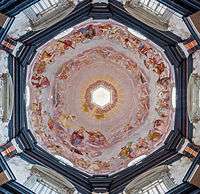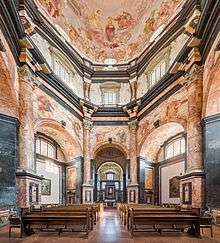Pažaislis Monastery
Pažaislis Monastery and the Church of the Visitation (Lithuanian: Pažaislio vienuolynas ir Švenčiausios Mergelės Marijos apsilankymo pas Elžbieta bažnyčia, Polish: Klasztor w Pożajściu) form the largest monastery complex in Lithuania, and the most magnificent example of Italian Baroque architecture in the country. Church of the Visitation is the most marble-decorated Baroque church of the Grand Duchy of Lithuania.[1] It is situated in the Petrašiūnai elderate of Kaunas, Lithuania, on a peninsula in the Kaunas Reservoir near the Kaunas Yacht Club. It was declared a cultural monument[2] and a site of Catholic pilgrimage in Lithuania.


History

Founded in 1662 by nobleman of Grand Duchy of Lithuania and Great Chancellor of Lithuania, Krzysztof Zygmunt Pac, for the Order of the Camaldolese Hermits, the main construction continued until 1674 and resumed in 1712. The monastery was designed by Pietro Puttini, Carlo Puttini and Giovanni Battista Frediani. Exclusive architectural solutions were used for the first time in Europe: a hexagonal church plan, and a concave facade. The interior stucco work is ascribed to Joan Merli and the frescos to Michelangelo Palloni. Krzysztof Zygmunt Pac burned the monastery construction bills before his death, saying, "What I have given to God, let him alone know." and was buried in the monastery according to his testament.[3] Writers of the time wrote that the construction cost 8 barrels of gold coins.[4] In 1755 the addition of the towers and the dome was funded by the king's chamberlain Michał Jan Pac.[5]
The monastery's church, decorated with highly polished marble, was damaged by the horses of Napoleon's army which was based in the complex. In 1832 the monastery was closed by the Russian authorities and later converted into an Orthodox church. The author of the Imperial Russian national anthem God Save the Tsar, Alexei Lvov, was interred there in 1870. In 1915-1918 when the Orthodox monks had fled a German war hospital was established in the monastery. The leaving Orthodox monks has stolen many treasures from the monastery, including the St. Mass Cup, decorated with over 1000 gemstones (over 400 diamonds, 300 rubies and 200 emeralds).[6] After 1920 the ruined monastery returned to Roman Catholics and was restored by sisters of the Lithuanian convent of St. Casimir. After World War II, the Soviet authorities converted the church and monastery into an archive, a psychiatric hospital and finally an art gallery (in 1966). In 1990s the complex was returned by the newly independent Lithuania to the nuns of the convent and reconstruction work began.[7]
The monastery has the painting of Mary Belle Mother and Child, revered by the congregation, two bells of the church and St. Romuald titles, cast in the seventeenth century and the oldest church clock tower in Lithuania.[7]
Music festival
Today the monastery is home to the annual international Pažaislis Music Festival. It was started in 1996 and now lasts for three summer months and offers about 30 different concerts. The festival was visited by Yehudi Menuhin twice. It features classical music of diverse genres and styles, ranging from Wolfgang Amadeus Mozart to ABBA classics. Other concerts have taken place in many different venues across Lithuania, such as the Kaunas Castle, Klaipėda University, and even the Pociūnai Airport.[8]
 The dome of the church of the Visitation
The dome of the church of the Visitation View of the ensemble from southwest
View of the ensemble from southwest Pažaislis interior
Pažaislis interior Decor of Pažaislis Monastery
Decor of Pažaislis Monastery.jpg) Pažaislis in winter
Pažaislis in winter The Great Gates
The Great Gates
References
- "Pažaislis – itališkas ansamblis Lietuvos miškuose". ldkistorija.lt (in Lithuanian). Retrieved 13 July 2020.
- "Pažaislio kamaldulių vienuolyno ansamblis". kvr.kpd.lt. Retrieved 16 November 2017.
- "Pažaislyje palaidotas K. Pacas prieš mirtį sudegino vienuolyno statybos sąskaitas". DELFI (in Lithuanian). Retrieved 11 July 2020.
- Kazimieras Dobkevičius. "Ar Pažaislio architektūros ansamblis – Lietuvos kultūros paveldo puošmena?". xxiamzius.lt (in Lithuanian). Retrieved 11 July 2020.
- "Kauno (Pažaislio) buvęs kamaldulių (dabar - Šv. Kazimiero seserų) vienuolynas". vienuolynai.mch.mii.lt. Retrieved 16 November 2017.
- "Profesorė: Pažaislis praranda nuolatos". KaunoDiena.lt (in Lithuanian). Retrieved 25 January 2015.
- "Ensemble of Pažaislis Church and Monastery". www.Lithuania.travel. Retrieved 16 November 2017.
- "Pažaislis music festival". Pazaislis.lt. Retrieved 16 November 2017.
External links
| Wikimedia Commons has media related to Pažaislis Monastery. |
- Church and Monastery of Pažaislis exterior video tour
- Laima Sinkunaite, The Pazaislis Monastery — A Baroque Pearl in Bridges journal, March 1999.
- Pažaislis Music Festival Official website.